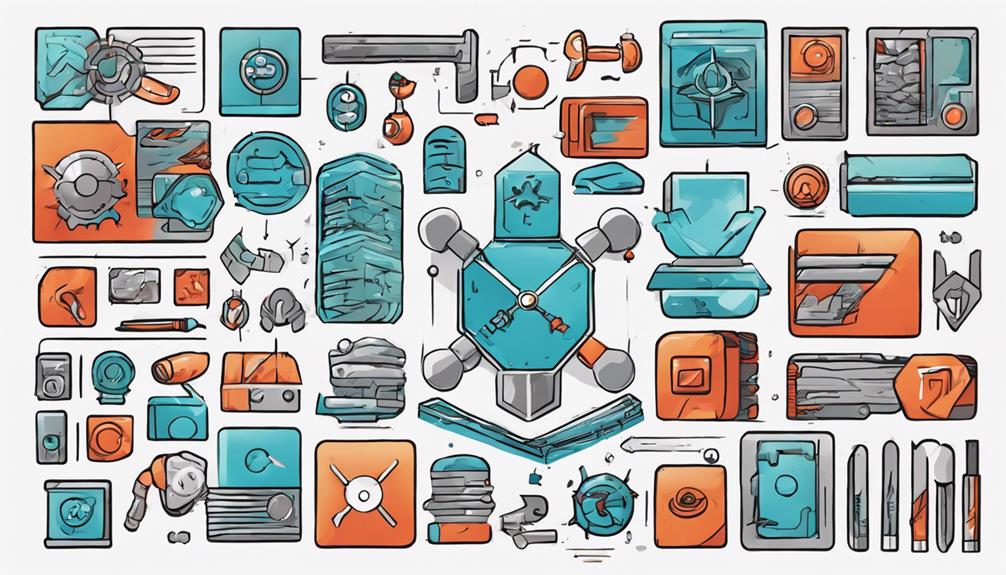Discover Kubernetes architecture through its master and worker node components, control plane functions, container networking, API server role, scheduler operations, and the pivotal Etcd key-value store. Uncover how these elements collaborate to streamline containerized applications. Each part plays an essential role in managing resources and ensuring seamless operations within your cluster. Understanding these core components will provide you with a detailed view of how Kubernetes orchestrates tasks and maintains cluster integrity. Explore further to gain deeper insights into the intricate workings of Kubernetes architecture.
Key Takeaways
- Master node components manage cluster state and configuration.
- Worker nodes execute and manage containerized applications.
- Control plane functions ensure efficient workload distribution.
- Container networking interfaces standardize networking configurations.
- API server serves as the primary interface for cluster management.
Master Node Components
Explore how the master node components in Kubernetes work together to manage the control plane efficiently. Within Kubernetes, the master node components play vital roles in orchestrating the cluster. The API server acts as the front end, receiving and processing requests to maintain the control plane's functionality. It serves as the primary interface for both external and internal interactions, ensuring smooth communication within the cluster.
Moreover, the scheduler component is responsible for efficient pod scheduling, considering each pod's resource requirements and constraints. By making informed placement decisions, the scheduler optimizes resource utilization and enhances overall cluster performance.
Additionally, the controller manager oversees various controllers that automate tasks and maintain the desired cluster state. This guarantees that the cluster operates smoothly and in alignment with the specified configurations.
Furthermore, etcd, a fault-tolerant key-value database, plays a pivotal role in storing essential cluster state and configuration data. By maintaining this centralized repository, etcd enables consistent and reliable cluster management.
Together, these master node components collaborate harmoniously to uphold the integrity and efficiency of the Kubernetes control plane.
Worker Node Components

Worker nodes in Kubernetes primarily handle the execution and management of containerized applications within the cluster. Each worker node runs pods, which are the fundamental units of deployment for applications. The kubelet service on worker nodes takes care of managing these pods and the containers within them.
Additionally, kube-proxy, present on worker nodes, is responsible for facilitating network communication and routing for the pods. Container runtime engines such as Docker or containerd are utilized on worker nodes to execute the containers that make up the pods.
In essence, the worker nodes play an essential role in executing and managing containerized applications within the Kubernetes cluster. They work in conjunction with the control plane to guarantee that pods are running efficiently and are able to communicate with each other as needed.
Control Plane Functions

Now, let's take a closer look at the vital functions of the control plane in Kubernetes.
The control plane consists of key components like the API server, scheduler, controller-manager, and etcd, each playing an important role in managing cluster state and resources.
Understanding how these components work together will give you a solid grasp of Kubernetes' control plane operations.
Control Plane Overview
How do the components of the Control Plane in Kubernetes work together to manage key functions within the cluster? The Control Plane, comprising the API server, Scheduler, Controller Manager, and etcd, plays a critical role in orchestrating the Kubernetes cluster. The API server acts as the gateway for communication, handling requests from both internal and external sources. The Scheduler is responsible for distributing workloads across nodes efficiently based on resource requirements. The Controller Manager ensures that the cluster maintains its desired state by overseeing various controllers that manage different aspects such as replication and endpoints. Meanwhile, etcd functions as the cluster's brain, storing configuration data and the current cluster state, aiding in making global decisions.
| Control Plane Component | Function |
|---|---|
| API Server | Communication Handler |
| Scheduler | Workload Distribution |
| Controller Manager | State Management |
Key Component Functions
Exploring the key functions of the Control Plane components in Kubernetes provides insight into how the cluster's essential operations are orchestrated and managed. The Control Plane, consisting of components like etcd, cloud-controller-manager, kube-scheduler, and kube-controller-manager, plays a pivotal role in maintaining the Kubernetes cluster's stability and efficiency.
Etcd serves as a reliable key-value store, ensuring cluster data consistency and configuration persistence.
The cloud-controller-manager facilitates interactions between the cluster and the underlying cloud provider.
Kube-scheduler handles pod scheduling by making informed decisions based on resource requirements and constraints.
Additionally, the kube-controller-manager oversees controller processes vital for automating activities and steering the cluster towards the desired state.
Together, these components work harmoniously to regulate the cluster state, make global decisions, and optimize pod placement, contributing to the overall robustness and functionality of the Kubernetes architecture.
Container Networking Overview

Container networking in Kubernetes plays an important role in facilitating communication between containers and hosts within a cluster. The Container Networking Interface (CNI) standardizes networking configuration for each pod by utilizing CNI plugins. These plugins enhance connectivity between containers, ensuring seamless communication within the cluster.
Efficient communication and data exchange between containers are crucial for the proper functioning of containerized applications in a Kubernetes environment. Additionally, Kubernetes Persistent Storage and PersistentVolumes (PVs) are vital components for maintaining persistent data storage across various applications running within containers.
Proper networking configuration is key to optimizing communication efficiency and enabling effective cluster communication. By implementing robust networking solutions and leveraging CNI plugins, Kubernetes users can enhance the overall performance and reliability of their containerized workloads within the cluster.
API Server Role

The API server in Kubernetes acts as the primary interface for the control plane, handling requests and maintaining cluster consistency. It serves as the centralized entry point for cluster management, exposing the Kubernetes API for both internal and external interactions.
Users, kubectl commands, and various Kubernetes components communicate with the API server, which validates and processes their requests. This essential component plays a crucial role in managing configuration data stored in etcd, ensuring cluster-wide consistency.
As part of the Kubernetes control plane, the API server is responsible for communication coordination within the cluster, facilitating seamless interactions between different resources. Accessible through tools like kubectl or direct REST calls, the API server is pivotal in orchestrating the overall functioning of the Kubernetes ecosystem, providing a robust foundation for efficient cluster operations.
Scheduler Operations

To effectively manage the allocation of resources and workload distribution within your Kubernetes cluster, the scheduler operates by assigning pods to nodes based on various criteria. The Kubernetes scheduler ensures high availability, fault tolerance, and peak performance by carefully considering factors such as resource allocation, anti-affinity rules, and node capacity.
Here's how the scheduler operations work:
- Resource Allocation: The scheduler analyzes the resource requirements of pods and the available capacity of nodes to make informed decisions on where to place each pod for efficient resource utilization.
- Workload Distribution: By considering quality of service metrics and workload distribution requirements, the scheduler distributes pods across the cluster to maintain balanced resource usage and prevent bottlenecks.
- Scalability: To achieve scalability and meet performance goals, the scheduler continuously monitors the cluster state and adjusts pod placements in real-time to accommodate changing resource demands and cluster growth.
Etcd Key-Value Store

Ensuring data consistency and persistence, the etcd key-value store is a critical component utilized by Kubernetes for storing cluster data and configuration information. etcd, being distributed and highly available, plays a crucial role in critical operations within Kubernetes. It prevents single points of failure by distributing data across the cluster, ensuring reliability and high availability. The data stored in etcd encompasses crucial information about pods, services, configurations, and other cluster resources. By maintaining the desired state of the cluster, etcd guarantees that the system operates as intended, facilitating seamless data storage and retrieval.
| etcd Key-Value Store | |
|---|---|
| Use | Data storage and configuration information |
| Importance | Ensures data consistency and persistence |
| Role | Critical for maintaining desired cluster state |
Frequently Asked Questions
What Is the Complete Architecture of Kubernetes?
Peek into the powerful Kubernetes architecture: The control plane orchestrates with kube-apiserver, etcd, kube-scheduler, and others. Worker nodes house kubelet, kube-proxy, and runtime for containers. Harness high availability, scalability, and efficiency with Kubernetes mastery.
What Is Kubernetes Network Architecture and How Does It Work?
In Kubernetes, the network architecture facilitates communication between containers and external resources within a cluster. It employs Container Network Interface (CNI) plugins to configure networking for each pod and utilizes network policies to control traffic flow.
What Is a Kubernetes Architecture Diagram?
Like a map guiding you through a city, a Kubernetes architecture diagram visually represents the components and interactions within a Kubernetes cluster. It illustrates relationships between control and node components, aiding in system understanding.
How Kubernetes Works in Simple Terms?
To understand how Kubernetes works in simple terms, it orchestrates containerized apps across nodes. The master node manages the cluster state, while worker nodes run app containers. Components like the API server, scheduler, and controller manager guarantee efficient deployment.
Can you provide a detailed breakdown of how Kubernetes architecture works?
Kubernetes architecture consists of several main components of Kubernetes architecture that work together to manage containerized applications. These components include the kube-apiserver, kube-controller-manager, kube-scheduler, kubelet, and etcd. Each of these plays a vital role in ensuring the efficient orchestration and management of containers within a Kubernetes cluster.
Conclusion
Now that you have a better understanding of how Kubernetes architecture works, you can see how it streamlines container deployment and management.
Imagine a company that successfully migrated their monolithic application to microservices using Kubernetes. By leveraging its flexible and scalable architecture, they were able to improve performance, reduce downtime, and increase overall efficiency.
This showcases the power of Kubernetes in revolutionizing the way applications are developed and deployed.









